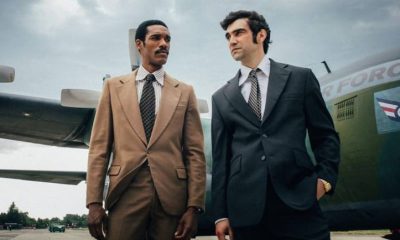Features
The Maltese Falcon and the making of the Bogart mystique
A doctoral thesis could be written (if it has not already been) on the changes in crime melodrama that occurred in the crowded ten years between the appearances of The Public Enemy in 1931 and The Maltese Falcon in 1941. These were years of prodigious shifting on the national economic and social scene, of significant fluctuation in public attitudes; and the contours of these modulations might be traced in the changing taste for crime in films.
The end of the Depression and the era of the lawless reign of gangs, which came with repeal of Prohibition and belated crackdowns on the barons of beer and booze, combined with the general surfeit of audience interest in repeated gangster films to render this type of entertainment temporarily de trop. Furthermore, an accumulation of moral outrage against violence on the screen had helped to compel the Hollywood nabobs to accept a self-restraining Production Code, which was enforced with heavy penalties, beginning in 1933. This code sternly limited the freedom with which gangsters consorted with their molls, the ferocity and noisiness of their gunfights, the grisliness of their dooms; and it compelled more forceful manifestation of the dictum that crime does not pay, even though the perceptive public was not convinced this was wholly true.
As a consequence, empathy was shifted from the gangsters to the guardians of the law. The G-man, the government agent who was bringing the gangsters to book, became the thunderous hero in the next wave of Hollywood crime films. At the same time, over in England, Alfred Hitchcock was developing a genre of fast and witty mystery thrillers pegged upon espionage and crime, in which empathy with the hunters and the hunted was elastically interchanged. His Murder (1930), The Man Who Knew Too Much (1934), The 39 Steps (1935) and The Lady Vanishes (1938) likened crime and its detection to the pursuit of an intellectual game. Then, too, there was a disposition, instigated by novels and plays, to consider the contemporary outlaws as cancers of a sick society, invading and corrupting a social body that was too much weakened to resist. Of such were The Petrified Forest (1936) and Dead End (1937).
High Sierra and the death of the old time gangster
Appropriately, the capstone to this cycle of reflective crime films was placed by Warner Brothers, the most prolific entrepreneur of the genre, with a picture called High Sierra in 1941. This was a roaring melodrama that ended with a fine Wagnerian death for “the last of the old-time gangsters,” a mordant John Dillinger type, brought to bay and gunned down by a small army of state policemen on a California mountaintop. The historic thing about it is that it coincidentally joined the principal parties, John Huston and Humphrey Bogart, who were to make what turned out to be the next major prototype of American crime melodrama. That is The Maltese Falcon, which followed High Sierra by only a few months.
Huston had been a writer at Warners’ and had collaborated on several successful scripts, among them Juarez (1939), Dr. Ehrlich’s Magic Bullet (1940), High Sierra and Sergeant York (1941). As a reward for his work on High Sierra, he was promised he might try his hand at directing, if he could come up with a good, inexpensive script. He had previously directed stage plays and had acted in the theater a bit. He was also the son of Walter Huston, a distinguished actor and motion-picture star.
One of his friends suggested he might get a good, tough script out of Dashiell Hammett’s The Maltese Falcon, a mystery novel which appeared in 1930 and was the forerunner of a considerable school of hard-boiled detective fiction that had become widely popular. The screen rights belonged to Warners, which had twice made films from it, neither of which amounted to much.
Huston broke down the text of the novel, roughing it out in scenes, with dialogue briefly indicated. A copy of this draft happened to reach Jack Warner, head of production at the studio. Warner was much impressed (he thought it the finished script) and immediately gave the go-ahead to Huston, who was joyfully surprised.
Hal Wallis, assigned as producer, wanted to get George Raft, one of the studio’s favorite tough guys, to play the leading role. But Raft was apprehensive. He had already turned down the role of the fugitive in High Sierra because he thought it too much of a stereotype, and the role had gone to Bogart, who played it superlatively. Now Raft feared the fellow in this one was too much on the wishy-washy side. So once again Bogart was recruited.
Humphrey Bogart’s Sam Spade talks business with Kasper Gutman aka The Fat Man played in fabulous style by Sydney Greenstreet.Hammett’s crisp style
The secret of Hammett’s work was the crispness of his writing and his tenacious knowledge of the sort of people he wrote about. He had been a private detectve and understood the ways and techniques of the sleuth. This was what Huston realized in preparing The Maltese Falcon as a film, and this is what he and Bogart sought in the leading character. Where Hollywood mystery crime films had pretty much emphasized the standard, surface elements of action, concealment and suspense, this would be an opportunity to generate excitement and surprise with the curiously off-beat, elusive and devastating character of the sleuth.
The picture begins as any average cops-and-robbers melodrama might, with a beautiful, somewhat cryptic woman calling on Sam Spade, a seedy-looking private detective, in his office in San Francisco. She wants him to help her locate a man who she says has influenced her sister to come with him out from New York. Evidently Spade is suspicious, but he agrees to take the job, he and his beady-eyed partner, when the woman puts up a $200 binder for their services.
So far, it’s ordinary. But the aspect and attitude of Spade—his somewhat shoddy appearance, his cool and vaguely insolent air, his way of treating the woman with politeness but obvious watchfulness—mark him at once as different from the ordinary sleuth. This fellow is just a bit tricky, someone you’ve got to watch.
This becomes more apparent as dire events rapidly occur—as Spade’s partner is shot while tailing the mystery man that night, then the man himself is murdered —and Spade is given a bit of a pushing around by the suspicious and inquisitive police. Is he a shady opera- tor? Did he do his own partner in? The mystery is quickly perking, and one of the big question marks is Spade.
It perks even harder the next morning when he goes to the apartment of the dame who hired him to do the sleuthing and toughly wrings out of her an admission that she misled him, that the story of her sister wasn’t true. This doesn’t in the least surprise him. “We didn’t exactly believe your story, Miss—what’s your name?” he says. “We believed your $200.” That lays it on the line. For an additional $500, he agrees to go on helping her. But what it is she wants him to do, outside of keep- ing her from being harmed by someone, she doesn’t say.
We begin to get an inkling, however, when a peculiar, prissy little man, a possible homosexual, shows up later at Spade’s office and offers him $5,000 to recover what he describes as a “certain ornament.” “Five thousand dollars is a lot of money,” Spade counters guardedly. The next thing he knows, the little man is covering him with a gun and saying he’s going to search the office for the “ornament.”
So this is it. The mystery woman is obviously mixed up in a plot of some sort involving an object of great value, and this little man, who is also in it somehow, figures that Spade is helping her, that he may even have the object or know where it is.
But now the intriguing aspect of Spade begins to emerge: he is distinctly fascinated by the temptations of this mystery. Although he is a private detective, presumably on the side of the law (he is a pal of the cops who grill him, even a drinking companion), and although there is not much question that something highly illegal is afoot, he is not going to back away from it. He’s sticking with it to see what’s in it for him.
Now we see Spade in action to the fullest extent of his skills—wheedling and abusing the woman, playing a cat-and-mouse game, sarcastically countering her hum- bug (“If you were as innocent as you pretend to be, we wouldn’t get anywhere”), kissing her when she wistfully asks him, “What more is there that I can buy you with?” and then insolently giving her to realize he is not to be diverted by sex.
From here on, we follow him closely as he becomes more and more involved in what turns out to be a complicated contention over a jeweled statuette, the fabulous Maltese Falcon. We follow him as he boldly exposes himself to peril from a noxious character, Wilmer, who is clearly shadowing the dame, in order to reach the Fat Man, the focal conniver in the plot. And we stay with him through a fantastic battle of wits with this monstrous character, an elegant international criminal on the order of those in the Hitchcock films.
Some of the best scenes in the picture are the stinging confrontations between Spade and the ruthless Fat Man, in which Spade shows himself to be every bit as clever as the criminal, able to baffle and outwit his pawns, the effeminate Cairo and Wilmer, able to manipulate the dame, who is evidently in with these rascals but attempting to pull a double cross, and finally to obtain the falcon and force them to pay him $10,000 to hand it over to them.
In these tricky maneuvers, we are led to discover that Spade is a man of amazing audacity, cynicism and amorality. He has all the instincts of the gangster to deceive and take for himself, yet he has the wit and wisdom to guard himself by staying just within the law.
Things start to get difficult for Sam.Spade’s mantra: Never trust anybody
He doesn’t trust anybody, not his partner, his client or the police. He respects only the Fat Man and, indeed, is amused by him because he finds him to be as clever, brazen and bold as is he.
Spade stays completely uncommitted to anyone but himself, and this is magnificently realized at the climax of the film. The jeweled falcon, which Spade has ob- tained mysteriously from the dying captain of a just-arrived ship, he has delivered to the Fat Man and his henchmen at their hotel. They have eagerly unwrapped it, eyes gleaming with excitement and greed. Then they have shockingly discovered that it is a fake; this object they have so fiercely maneuvered to get their hands on is merely clay and glass!
They snivel and snarl in dejection, then the Fat Man and little Cairo leave, unable to compel Spade to give back the $10,000 they have advanced to him. He is left alone with the woman, who now tries to make up to him, assuming that he will take her. After all, she brought him into the case. But he icily rejects her and deliberately turns her over to the police as the one responsible for the murder of his partner and the other man.
Here is stated the essence of the personal philosophy of Spade: “If I did this (attached himself to her) and got away with it, you’d have something on me you could use whenever you wanted to. And since I’ve also got something on you, I couldn’t be sure you wouldn’t decide to shoot a hole in me someday.” All they’ve got going for them, he tells her, is “maybe you love me and I love you.” But what is love? A likely headache; perhaps a pair of horns! And when she indicates amazement at his ambiguous morality, he says, “Don’t be too sure I’m as crooked as I’m supposed to be.”
This fine entertainment and comment is splendidly played. Sydney Greenstreet is devilishly suave in the crucial role of the Fat Man (Huston recruited him from the New York Theater Guild and he was making his film debut here), Mary Astor is deliciously and blandly deceitful as the dame, Peter Lorre is obscenely innocent as Cairo and Elisha Cook, Jr., is wicked as Wilmer. Lee Patrick as Spade’s doting secretary (whose adoration is almost a joke) and Barton MacLane as the chief of detectives make it stick.
Camera eye storytelling
Being largely verbal in conveying the details of the plot, one might fear that The Maltese Falcon would be static cinema. But Huston, with the excellent assistance of Arthur Edeson as cameraman, keeps it moving, always moving. Spade is in focus throughout. The camera is virtually a detective constantly shadowing him, standing off to one side and peeking as he goes into a room, tailing him to the District Attorney’s office, never letting him out of sight. This is camera-eye storytelling, good, straight, traditional story telling.
In the final analysis, however, it is the stringent character of Spade and Bogart’s brilliant performance that make this a truly great film. It is a character that subtly communicates the attitude of an age—skeptical, disillusioned, resistant to commitment, detached. Underneath its demimondain surface, it states the feelings of many who were disabused of pious idealism by the out- break of the Second World War within a decade of the Depression. And it continues, unto this day, to satisfy the people who are doubtful of the society in which they live.
Shortly after release of The Maltese Falcon, Huston was commissioned a lieutenant in the Army Signal Corps and was called, right after Pearl Harbor, to make imformation films. His Report from the Aleutians and San Pietro, the latter a savage account of the winter-long battle of American G.I.s to capture an Italian hill-top town, were first-class war documentaries. And his Let There Be Light, a fact film about the treatment of psychoneurotic battle veterans, was a masterpiece of its sort. Unfortunately, the Army never allowed the last film to be publicly released.
Bogart, already past forty, made some fascinating films during the war, among them Casablanca, in which his character, the “saloonkeeper” Rick, is a virtual duplication of the cynical Sam Spade. Indeed, there’s a little bit of Sam Spade in every role Bogart played after that, and this image he thereby fabricated is the core of the so-called “Bogart mystique.”
The Maltese Falcon was made by Warner Bros and released in 1941.
The screenplay was by John Huston who also directed from Dashiell Hammett’s novel. Cinematography was by Arthur Edeson and producer was Hal B. Walls.
Humphrey Bogart played Sam Spade; Mary Astor was Brigid O’Shaughnessy; Sydney Greetstreet was Kasper Gutman aka The Fat Man; Peter Lorre was Joel Cairo and Elisha Cook Jr was Wilmer Cook.













































